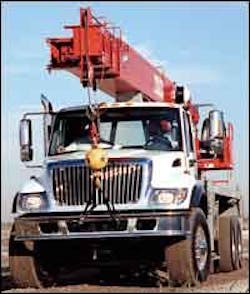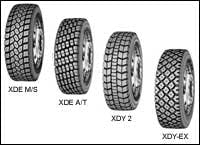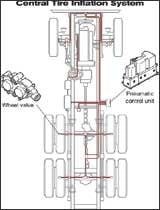How to Specify Trucks for Off-Road Performance
Specifying a truck, of course, is the process of choosing individual components that come together on the assembly line to create a vehicle that's just right for your application. In its "Precision Truck Training" course, the Truck Marketing Institute (TMI) uses a 392-page manual to teach the fundamentals of specifying. TMI's director, Rob Godfrey, was kind enough to send us a copy, which we've had the audacity to try summarizing in one sentence. So take a deep breath.
Truck specifying is a process of first choosing a frame, suspension members, axles, wheels and tires that create a platform strong enough to carry intended loads, legally, then selecting a power train that that will move these loads efficiently in all anticipated situations.
For on/off-road work trucks, moving loads efficiently requires considerable power-train flexibility. If a dump truck hauling 15 tons of aggregate is to have a chance at keeping up with expressway traffic, for instance, then a critical requirement is adequate horsepower. But if the truck also is expected to turn into construction sites with boot-deep mud and steep inclines, then it also needs plenty of torque. In reality, specifying heavy trucks that will spend a significant portion of their lives in severe off-road conditions can be somewhat of a compromise between ensuring they have an adequate "geared" (highway) speed, yet power enough to handle tough going off-road.
That said, specifying a truck for good off-road performance, basically, involves two major considerations. First is designing in enough torque (twisting force at the axle shafts) to overpower adverse terrain. The other is equipping the truck with features that improve drive-wheel traction, because once the wheels slip, all the torque in the world will do no good.
In our digital world, of course, designing a truck with adequate torque can be as simple as plugging the right variables into the right software. But behind it all is basic math and human logic that you may find interesting—and helpful—when considering off-road performance.
To simplify the discussion, let's assume were considering a 6×4 straight truck, a rear dump, having a tandem, single-reduction drive axle with a ratio of 4.5:1. The transmission has a low-gear ratio of 12:1, and the engine produces 900 lb.-ft. of peak (maximum) torque. The truck weighs 44,500 pounds loaded (33,000 pounds on the tandem and 11,500 pounds on the front axle) and rides on 11R22.5 radial tires, which have a loaded rolling radius (wheel center to bottom of tread) of 20 inches.
Theoretically, the total torque available at this truck's axle shafts is 48,600 lb.-ft., which is the product of the engine's peak torque, the transmission's lowest ratio and the drive-axle ratio (900×12×4.5).
But all this torque doesn't reach the axle shafts. Friction and heavy lubricants within components, plus heavy driveshafts, can absorb up to 25 percent of the total, depending on vehicle configuration. Nor is the total force at the axle shafts, measured in pounds-feet (lb.-ft.), normally converted to thrust at the drive wheels, measured in pounds. The reason? The application of torque is based on a force working through a 1-foot lever; a longer lever, that is, a drive wheel with a loaded rolling radius greater than 12 inches, can't convert every lb.-ft. of torque into a pound of thrust at the road surface.
So, how can you determine, theoretically at least, the amount of torque converted to thrust where the rubber meets the road? You can do that by calculating "tractive effort" (TE) with the formula we lifted from TMI's manual.
Torque × Ratio × Efficiency × 12 TE = Loaded Rolling Radius
"Efficiency" is a measure of the power-train torque actually delivered to the axle shafts. Let's assume 80 percent (0.80). "Torque" is peak engine torque (900) and "Ratio" is overall drivetrain reduction (12.0×4.5). The loaded rolling radius of our truck is 20 inches. Thus, tractive effort produced is 23,328 pounds. (If the truck had an automatic transmission, the torque converter's stall ratio also would be factored into overall ratio.)
Once you know tractive effort, you can get at the most tangible measure of a truck's off-road performance, that is, "gradeability." In simplest terms, off-road gradeability equates to the steepest hill (grade) a truck can climb when running at peak engine torque in its lowest transmission gear (and lowest rear-axle ratio if the axle has a double reduction).
For example, a truck climbing a haul road with a 12-percent grade (rising 12 feet vertically in 100 linear feet) would need 12-percent gradeability to reach the top. And, for every inch the truck's tires penetrate into soft ground, says TMI, an additional 6 percent gradeability is required. So, if the truck's tires sink 3 inches into loose gravel on the 12-percent grade, then the truck would need 30-percent gradeability (12 + 18) to get up the hill.
But what if a crew filling low spots in the haul road momentarily stops the truck on the grade? According to TMI, the average truck with a manual transmission needs around 10 percent gradeability just to get moving from a dead stop. Our example truck, then, better have at least 40-percent gradeability (10 + 12 + 18), or rolling backward down the hill may be the only option.
The following formula calculates gradeability (G). You need to know tractive effort (TE) and gross weight (GW), which for our truck, respectively, are 23,328 and 44,500 pounds. The resulting gradeability is 52.4 percent.
G (%) = 100 TE/GW
In its "Precision Truck Training, Course III, Heavy-Duty Models," TMI suggests a minimum gradeability of 40 percent for on/off-road construction trucks. One method TMI suggests for determining an approximate gradeability requirement for these vehicles is assuming 10 percent for "startability" (moving from a dead stop), then adding in the requirement for the steepest anticipated grade, plus 6 percent for every inch of tire penetration in the worst ground conditions anticipated.
(In truth, we've left off part of the gradeability formula that deducts for the "rolling resistance" between the truck's tires and the road surface, suggesting instead the use of TMI's guideline for tire penetration.)
The formula for gradeability assumes that the truck can use all of its tractive effort. But sometimes it can't, because the drive wheels may slip before using all the available force. Usable tractive effort is determined by two factors: drive-axle weight and the coefficient of traction, which is akin to the coefficient of friction, but has to do with rolling, not sliding, contact. Coefficients range from 0.80 on dry concrete, to 0.10 on wet, ice-covered pavement.
But off-road, determining coefficients of traction can be tricky. For the sake of illustration, however, let's assume dry clay has a rating of 0.55. Thus, to find the theoretical amount of tractive effort our truck can apply before spinning its wheels in this material, multiply its weight on the drive axles (33,000 pounds) by the coefficient (0.55). The result is 18,150 pounds. Now, if you use this as the TE number in the preceding gradeability formula, the result is 41 percent.
If a truck comes up short on gradeability during the specifying process, then increasing tractive effort by increasing power-train torque can be a solution. This can be done, basically, by choosing an engine with more peak torque, or by boosting the drive train's overall reduction ratio. Methods for accomplishing the latter include transmissions with deep low gears (both forward and reverse), auxiliary transmissions and two-speed axles.
Auxiliary transmissions, positioned behind the main transmission, have gear sets that provide a 1:1 ratio when extra torque isn't required, and a reduction ratio, perhaps 2.3:1, to boost the torque of gearing in the main transmission. (With the advent of more capable main transmissions, some with integral auxiliary sections, the use of separate auxiliaries has declined.)
Two-speed axles provide two reduction ratios, one that yields acceptable highway speeds, and one that provides even further multiplication of torque from the transmission. Two-speed axles switch to deeper ratios via a planetary gear set or an added set of hypoid gears, and they may provide ratios as deep as 10:1.
Considering all the possibilities for the moment, you could also improve the gradeability of our example dump truck by specifying a powered front axle. Since the truck would now have all its loaded weight on drive axles, 44,500 pounds, it could potentially utilize 24,475 pounds of tractive effort at a 0.55 coefficient of traction. Since that's more tractive effort than it produces, it could employ its full gradeability, 52.4 percent.
Traction is a measure of how effectively the truck uses its available tractive effort. An essential aspect of traction, then, is keeping the tires firmly planted on the ground, even in difficult terrain. A suspension system that provides the needed axle articulation in these tough conditions can go a long way toward ensuring adequate off-road traction.
The traction potential of the axles themselves, of course, can be enhanced by equipping differentials with "torque-proportioning" or locking capability to assist in splitting torque more evenly side-to-side when one wheel loses its grip. In multiple-drive-axle configurations, an inter-axle differential with a lockup feature can ensure that each axle receives its fair share of torque when the axles have unequal footing.
Also available for some trucks is an automatic traction-control (ATC) system. Typically, ATC systems are used in conjunction with anti-lock braking systems (ABS), and the two may use common components to monitor wheel speed. The ATC system improves traction by automatically "tapping" the brake of a spinning drive wheel, thereby slowing the wheel's waste of tractive effort and transferring torque to wheels with better grip.
Tires, inflation and tag axles
Tires, of course, are the truck's "appliers" of tractive effort. Tires for on/off-highway trucks must balance off-road abrasion resistance and aggressive traction characteristics with acceptable highway performance and tread life, and to do so for a variety of applications. That's why you may see a wide selection of on/off-road tires from a given manufacturer, each using a different tread pattern and rubber compound to best strike the needed balance. Consulting a tire manufacturer or a knowledgeable tire dealer is still the best advice.
A tire-related innovation aimed at improving off-road traction is the central tire inflation (CTI) system. A CTI system allows the driver to adjust tire pressure to suit ground conditions, meaning tires can be partially deflated in soft soils to lengthen their footprint and place more rubber on the ground. One system maker claims a 5-percent gradeability increase at low-pressure settings, versus higher settings, and says the system can be more effective than adding a drive axle. Proponents say also that softer tires are less susceptible to off-road damage and cause less haul-road rutting.
And here's one last item. According to TMI's Godfrey, a truck equipped with a "liftable" trailing axle can increase traction by raising the axle (partially or fully) to place more weight on the truck's rear drive wheels during off-road maneuvering. But if this is your plan, he says, make sure the rear axle can handle this temporary extra weight, perhaps by equipping it with a heavy-duty housing.
Construction Equipment thanks the following organizations for their help in preparing this report: Dana, Eaton, Mack Trucks, Michelin Americas Truck Tires, International Truck & Engine, ZF Meritor LLC, and the Truck Marketing Institute, Carpinteria, Calif.



